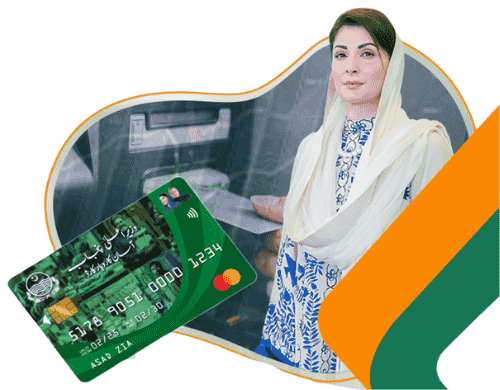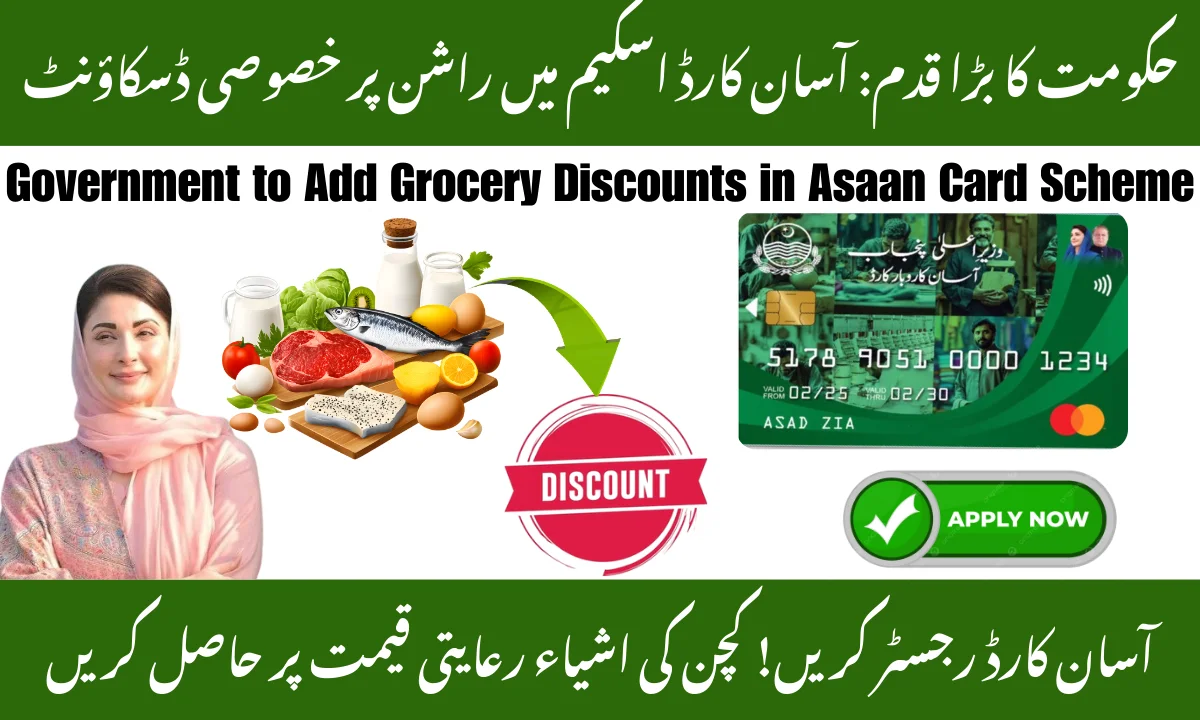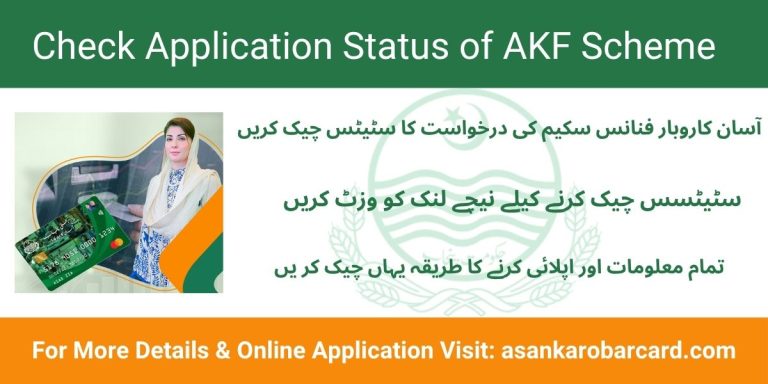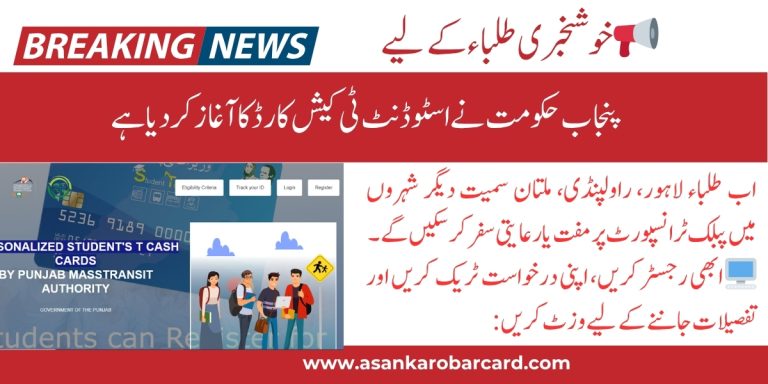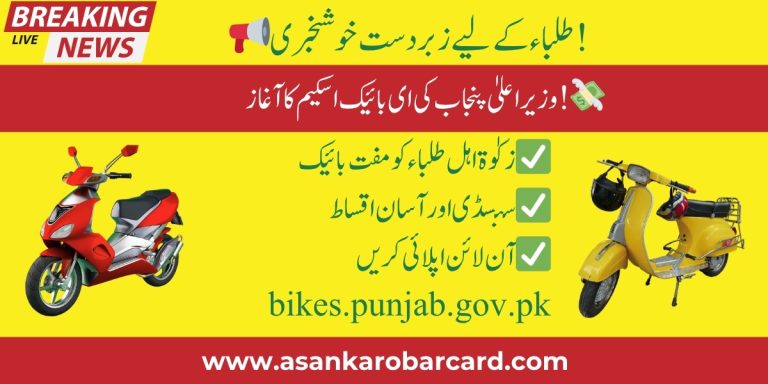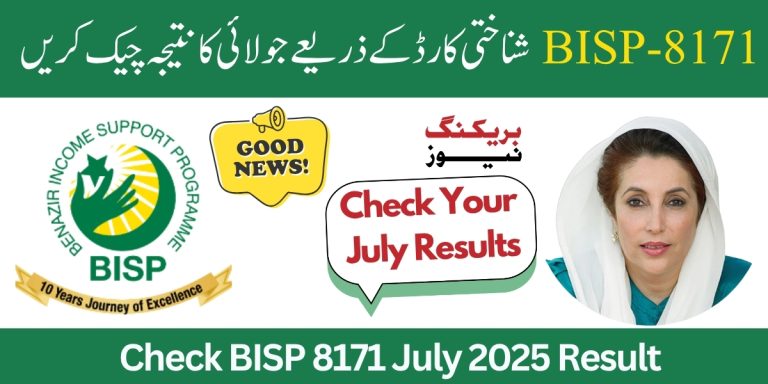Government to Add Grocery Discounts in Asaan Card Scheme 2025 – Get Discount Rashan Today
Pakistan is facing one of the toughest economic times in recent years. Rising inflation has made it very difficult for families to afford daily groceries and household essentials. In this situation, the government has been introducing different welfare schemes to give relief to common people.
The Asaan Card Scheme is one such initiative launched to support low-income households, daily wagers, and poor families who are struggling to manage basic needs. Initially, the card provided financial support and assistance with utilities, but the government has now taken a step further.
Recently, the Government to Add Grocery Discounts in Asaan Card Scheme has been officially announced. This update is seen as a major relief package for inflation-hit families. Grocery discounts will help reduce monthly household expenses and make food more affordable.
Through this program, families will now be able to purchase essential items like flour, sugar, rice, cooking oil, ghee, pulses, and tea at discounted rates. This is a major step toward ensuring food security, economic stability, and welfare support for those who need it the most.

Key Highlights of the Article
| Feature | Details |
| Scheme Name | Asaan Card Scheme |
| New Update | Government to add grocery discounts |
| Main Objective | Provide inflation relief and food security |
| Eligibility | Low-income families, daily wagers, BISP beneficiaries |
| Registration Methods | Online portal / SMS & Offline through Utility Stores / NADRA centers |
| Essential Items Covered | Flour, sugar, rice, ghee, pulses, tea, milk, detergents |
| Card Features | Digital subsidy card, QR-code monitoring, balance check online |
| Total Benefits | 15 major benefits for poor & middle-class families |
Background of the Asaan Card Scheme
The Asaan Card Scheme was introduced as part of the government’s broader welfare programs to provide targeted subsidies and financial assistance. The aim was to support poor households, especially during periods of high inflation and rising cost of living.
Previously, beneficiaries could use the Asaan Card for cash support and paying utility bills. However, the increasing price of groceries pushed the government to expand its scope. By including grocery discounts, the scheme has now become more meaningful for low-income families.
This initiative is linked with the Prime Minister Relief Package and will be implemented through Utility Stores Corporation and partnered retailers across the country.
Government’s New Initiative: Grocery Discounts
The Government to Add Grocery Discounts in Asaan Card Scheme means that thousands of families will now enjoy subsidized prices on essential food items. The government has allocated a special budget to ensure smooth implementation of this policy.
Discounts will be available on:
- Flour
- Sugar
- Rice
- Cooking oil and ghee
- Pulse
- Tea
- Milk
The Utility Stores Corporation will be the primary distributor, but private retail chains and kiryana shops may also join to make it easier for beneficiaries to access discounts.
Eligibility for Grocery Discounts
Eligibility criteria ensure that the support reaches the most deserving families:
- Low-income households below the government’s set income threshold.
- Registered BISP (Benazir Income Support Program) beneficiaries.
- Daily wagers, laborers, and unemployed individuals verified by CNIC.
- Families with widows, orphans, or senior citizens.
- Households without access to other government subsidy schemes.
- Residents of both urban and rural areas who meet requirements.
- Pakistani citizens holding a valid CNIC.
Required Documents
To apply for the grocery discounts under the Asaan Card Scheme, applicants must provide:
- CNIC (Computerized National Identity Card) of the head of family.
- Proof of income such as salary slip, labor card, or income certificate.
- Household details (number of family members, dependents).
- Recent utility bill or proof of permanent residence.
- BISP or Ehsaas registration slip if already enrolled.
- Passport-size photographs of the applicant.
- Mobile phone number for SMS verification and updates
Registration Process for Grocery Discounts
The registration process for the Asaan Card Scheme is simple and user-friendly. Beneficiaries can register through two methods:
a) Online Registration Method via Online Portal
- Visit the official Asaan Card portal.
- Enter CNIC and personal details.
- Verify through SMS code.
- Submit the application.
- Wait for confirmation message.
b) Offline Registration Method via SMS Method
- Visit nearest Utility Store or NADRA center.
- Fill out the registration form.
- Attach CNIC and required documents.
- Submit an application to the counter.
- Receive receipt and later confirmation.
How Beneficiaries Can Check Their Balance Online
Beneficiaries can easily check their available balance in two ways:
- Online Portal: Login using CNIC to view remaining subsidy balance.
- SMS Inquiry: Send CNIC number to the given code and receive balance details.
- Mobile App / Banking Integration: In future, the government plans to integrate balance check with mobile apps for ease.
List of Essential Items Covered
The grocery discounts cover a wide range of basic household items.
| Essential Item | Discounted Category | Availability |
| Flour | Wheat flour (Atta) | Utility Stores, Retailers |
| Sugar | Refined Sugar | Utility Stores |
| Rice | Basmati / Local Rice | Utility Stores & Private Shops |
| Ghee / Oil | Cooking Oil & Ghee | Utility Stores |
| Pulses | Daal Masoor, Chana, Moong, Mash | All outlets |
| Tea & Milk | Packaged Tea, Powdered Milk | Utility Stores |
| Soap & Detergent | Basic Household Essentials | Selected Stores |
Role of Utility Stores Corporation & Retail Partners
The Utility Stores Corporation (USC) has a long history of being the central hub for government subsidy distribution. With outlets spread in almost every district, USC is in the best position to ensure that grocery discounts under the Asaan Card Scheme reach deserving families. Prices will be regularly monitored and adjusted to make sure that subsidized items remain within reach of ordinary people, even during sudden market fluctuations.
In addition to USC outlets, the government is also building partnerships with private kiryana shops and supermarket chains. This step is crucial because many rural families cannot easily access USC branches. By including local retailers, the government ensures that no one is left behind. These retail partners will follow a fixed pricing structure, making groceries more affordable and preventing overcharging.
This collaboration will also encourage healthy competition among retailers, which can further bring down prices. For consumers, it means more convenience, shorter travel distances, and better access to essential food items right in their neighborhoods.
Digitalization of Subsidy Distribution
The digitalization of the Asaan Card Scheme is one of its strongest features. By using QR-code scanning and digital records, every transaction is logged in real-time, which makes the process transparent and reduces the risk of fraud. Beneficiaries can use their card at USC or partnered retail outlets, and the discount will be applied automatically at checkout.
This digital system not only ensures that subsidies are reaching the right people but also helps the government keep accurate data about how much relief is being used and where it is most needed. Such tracking helps in future policy-making and better budget allocation.
Furthermore, the digital platform will be linked with mobile banking systems and apps in the future, allowing families to check their subsidy balance instantly. This reduces dependency on physical receipts and helps beneficiaries manage their grocery planning more effectively. It also builds public trust in welfare programs, as people can see their benefits being applied transparently without any middlemen.
Objectives of Adding Grocery Discounts
The new grocery discount feature in the Asaan Card Scheme has several objectives:
- Fight food inflation by stabilizing grocery prices.
- Provide direct relief to low-income households and daily wagers.
- Ensure food security for poor and middle-class families
- Reduce financial pressure on households already struggling with rising costs.
- Build trust in government welfare programs by offering tangible relief.
- Encourage transparency in subsidy distribution through digital systems.
- Support rural and remote area families who often face higher food costs.
Features of the Updated Asaan Card Scheme
The updated version of the scheme offers several key features:
- Digital subsidy card system to prevent misuse.
- QR-code scanning at checkout to track transactions.
- Discounts available at Utility Stores and private kiryana shops.
- Monthly allowance for essential food items and household goods.
- Online and SMS balance check facility for beneficiaries.
- Easy registration process through online and offline methods.
- Nationwide coverage with rural outreach programs.
- Seasonal subsidy offers, especially during Ramadan and Eid.
Benefits of the Grocery Discounts
Here are the 15 major benefits of adding grocery discounts under the Asaan Card Scheme:
- Reduced grocery bills for families.
- Direct support for daily wagers.
- Relief for low-income households.
- Better access to affordable food.
- More trust in welfare schemes.
- Stronger food security program.
- Control on black market pricing.
- Encouragement for local shopkeepers.
- Help for middle-class families.
- Coverage in both urban and rural areas.
- The digital system ensures transparency.
- Balance check available online.
- Additional relief during Ramadan and special seasons.
- Long-term support for poverty reduction.
- Boost to social and economic stability.
Impact of Grocery Discounts on Families
The grocery discounts introduced under the Asaan Card Scheme are expected to bring real relief to struggling families. For many households, almost 50–60% of their monthly income is spent on food. By lowering the prices of essentials such as flour, sugar, rice, pulses, and ghee, families will be able to save a significant amount every month. These savings can then be redirected towards other urgent needs like education, healthcare, or transportation, improving the overall standard of living.
Another important impact is on the psychological well-being of families. Constantly worrying about daily meals creates stress and hopelessness, especially among low-income groups. With the Government to Add Grocery Discounts in Asaan Card Scheme, families will have greater food security and stability. This peace of mind not only improves the quality of life but also creates a positive environment where parents can focus on their children’s future rather than struggling to put food on the table.
Comparison with Previous Relief Packages
When compared to earlier welfare efforts like the Ehsaas Program or the BISP ration package, the Asaan Card stands out due to its structured approach and digital transparency. While past schemes did provide short-term relief, they often lacked monitoring and long-term planning. The Asaan Card, on the other hand, ensures that beneficiaries receive their discounts through a digital subsidy card, preventing corruption and misuse. This makes it more reliable and sustainable compared to earlier models.
Another key difference is the wider network of distribution. Past packages were usually limited to certain outlets or government centers, which left many families in rural or remote areas without access. Now, by involving both Utility Stores Corporation and private kiryana shops, the scheme becomes more inclusive. This dual distribution system ensures that support reaches every corner of the country, creating a fairer and more balanced relief system than ever before.

Conclusion
The announcement by the Government to Add Grocery Discounts in Asaan Card Scheme comes at a time when inflation has hit ordinary families the hardest. By reducing the cost of essential items like flour, rice, sugar, and ghee, the government has taken an important step toward ensuring food security and economic relief. This move not only supports low-income households but also strengthens the social protection framework of Pakistan.
What makes this scheme different from previous relief packages is its focus on digital transparency and wider accessibility. With QR-code scanning, online balance checks, and participation from both Utility Stores and private kiryana shops, the scheme ensures fair distribution and convenience for beneficiaries. Families in rural and remote areas will also find it easier to access discounts, something that was often missing in earlier programs.
If implemented with proper monitoring and accountability, this initiative can set a new standard for government welfare schemes. The Asaan Card Scheme has the potential to improve lives, reduce poverty, and restore confidence in social safety nets. For thousands of families struggling with food inflation, this grocery discount feature is more than just financial support, it is hoped for a more secure and stable future.
Frequently Asked Questions (FAQs)
1. What is the new update in the Asaan Card Scheme?
The latest update is that the Government will add grocery discounts under the Asaan Card Scheme, allowing families to buy essential items at subsidized prices.
2. Who is eligible to apply for the grocery discount scheme?
Low-income households, daily wagers, BISP beneficiaries, widows, and families below the government’s set income threshold can apply.
3. How can beneficiaries register for the Asaan Card grocery discounts?
Registration can be done online through the official portal/SMS system or offline at Utility Stores and NADRA centers by submitting CNIC and required documents.
4. How can I check my Asaan Card balance online?
Beneficiaries can check their balance via the official portal login, SMS code inquiry, or future mobile app integration.
5. What grocery items are covered under the discount scheme?
Essential items like flour, sugar, rice, pulses, ghee, oil, milk, and tea are included, along with basic household goods such as detergents.
